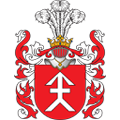Liubavas manor » Personalities » The Golejevskis family

The Golejevskis family
On April 5, 1577 Kasparas Golejevskis (Kasper Golejewski) bought the manor from Mikalojus Radvila "the Red" (Mikołaj Radziwiłł Rudy) for 2,000 Lithuanian kapa. These documents mention the same fish ponds, which provided an especially valued fish for the ruler`s table in Žygimantas Augustas' times.
Enough history exists about Radvila "the Red", but the other owners, who occupied the manor after Radvila, were some of the most mysterious in the history of Liubavas. There is little known about the Golejevskis (Golejewski) family, who lived in the manor after Radvila. The secondary sources like heraldry and biographies of distant relatives helped to create a family portrait. This family had a very old coat of arms, known as the Kościesza, which was known since the 11th c., and documentation of the Golejevskis family reaches back to the 15th c. It is thought that the family descended from Mazovia and had the title of earl. The family's representatives participated in Parliament, were treasurers, elders, pursers and hold other higher level positions.
Liubavas owners came from this old, respectable, aristocratic family. Their biographies are supplemented with some excerpts from documents of ownership. From this information, it becomes clear that Kasparas Golejevskis and his son Mikalojus (Mikołaj) were well taken care of financially. Kasparas Golejevskis managed to acquire this property from Radvila himself, and his son bought a large amount of the surrounding lands, which included the very large Nemenčinė Estate, which belonged to Zaviša (Zawisza) at the time.
The acquisition of Liubavas was very important for the new owner Golejevskis, because it helped him to annex earlier purchased property. After his death, his son Mikalojus continued to expand the estate, and in 1614, he annexed part of Nemenčinė. In 1636, by right of inheritance, the estate of Liubavas was divided amongst three of Mikalojus' heirs: Jonas, Martynas, and Samuelis (Jan, Marcin, Samuel).





